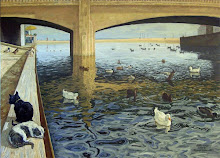The Under Minerva Gallery’s current exhibition, "Passing By," running from March 6-April 11, presents us with the work of two artists, Eric Graham and Chris Hagerty. The show is curated by Vanessa Juriga, and is accompanied, in the rear of the gallery, by the work of the 10 artists currently working in Under Minerva’s Artists’ Den, as is the gallery’s practice. The latter I will review in a separate posting.
The "Passing By" show’s theme is given as “The abandonment of rural America for an urban existence. Through an investigation of landscapes, isolation and the transformation of culture, both artists... [respond] to this drastic shift in society....” Where these ideas are not perfectly explicit, they run throughout the exhibition in implied form.
The hanging of the show, which intersperses the two artists’ work, facilitates contrasts and comparisons between the two. Both artists work with the “and”-ness of disparate juxtaposition. Chris Hagerty shows us the more obvious juxtapositions in his consistently jarring combinations of malls painted in synthetic, flat, hard edged shapes, and sooty, grungy, immolations of automobiles, always depicted in a powdery touch. Eric Graham, on the other hand, emphasizes the isolation of his objects by laying in flat grounds all about them. These flat fields suggest, to me, not emptiness, but the contrast of flat paint with the house, or the window, or, whatever the chosen item. It may be seen to negate the represented object, or, perhaps, to contrast it’s naturalness with the synthetic artificiality of art. Whether this flatness represents some concept is open to conjecture.
In one of Mr. Graham’s pictures, “Reclamation,” 2008, what appears to be an adobe house in an arid landscape stands in eternal isolation with its partially caved in rafters of the front porch, broken windows, and a facade badly needing repointing, with red bricks showing through cracks. I found the depiction of this subject rather handsome. The isolating agent, in this case, is a coat of a sort of beige-brown. Here I noticed some rather casual brush marks toward the upper center of the painting. I hadn’t seen such visible casualness in any of the artist’s other backgrounds, and I tend to think of it as a stylistic “hiccup,” or a weak moment in the execution. Opinions vary, of course, and the next viewer may be glad for reassuring evidence of the human hand.
Mr. Hagerty consistently sets up his views of urban dilapidation through openings in the mall architecture. In Atlantic Mall and Wreck, 2008, the space underneath a broad, shallow arch and corridor reveals a mutilated car. The contrasting handlings of the two sections, the pure pigment and clean edges of the one, vs. the grunge and grime of the other, bring together two locations onto the same plane. Two coexisting but mutually exclusive states of mind appear before us.
In other pieces, again, Chris Hagerty shows us a war scene brought home to us. The flat colors of the mall are apt to “burn” brighter than the nominal fire in the urban blight encroaching on the scene, with their unbridled optical vibrations. This is the case especially in “Atlantic Center Mall and Wreck,” 2009, where the Christmasy, red and green alternating bands describing the escalator steps vibrate so eye-poppingly.
I return to Mr. Graham’s work to describe the piece I found the best by this artist in this exhibition. “The Last Picture Show,” 2006, is set in a drive-in movie theater with an air of neglect. The principal character on this scene seems to be a smokestack leaning in toward the left with a great deal of personality. Here the artist seems to be at his finest in terms of object description. He shows us the stack’s rusty-looking hat-like shape on top, with a very well observed surface. The flaking of the paint reveals either silver metal patches underneath brown, rusty looking paint, or a lot of brown, rusty metal under some remnants of silver paint. I couldn’t tell which it was. But the depiction, somehow, had the sensation of the real.
Under Minerva Gallery and Event Space
656 5th Ave., Brooklyn, NY 11215 (between 19th/20th St.)
Gallery Hours: Tuesdays-Fridays 12-6 P. M.. Saturdays 2-6 P. M..







No comments:
Post a Comment